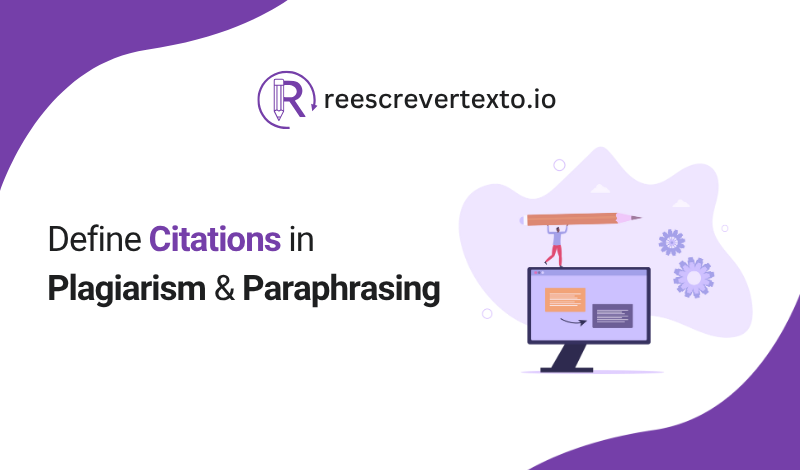
Defining citations to understand plagiarism and paraphrasing
When writing papers or articles and using someone else's ideas, knowledge, and scholarly work, the question of plagiarism or copyright infringement replacement comes to mind. The plain answer to this is learning the citation definition. Citations are how you credit the sources of the information you used, and they show the credibility of the writer.
Many students ask about citations meaning, especially when learning how to include other people’s ideas in their work. A citation will show the original author of the work you used. When you give credit properly, you not only respect intellectual property but also strengthen your writing.
What Does a Citation Mean?
If you’ve ever wondered how to cite a source, you’re not alone. Every citation follows a specific style, like APA, MLA, or Chicago, depending on your field. Each format includes details such as the author’s name, publication year, and page number. It helps readers locate the exact source of your reference.
Some people confuse the word “citation” with legal terms and ask, is a citation a ticket? The answer depends on context. In writing, a citation refers to acknowledging a source, while in law, it can mean a notice from authorities. So, the meaning changes based on how you use it.
Why are citations so important?
Students constantly ask how to cite a paraphrase or when to do so. In simple terms, you need to cite every time you restate someone’s ideas, even if you put them in your own words. This helps keep your writing honest and avoid plagiarism.
You can find cite examples in academic papers, research reports, and online instructional content. These examples demonstrate how to properly format a citation depending on the type of source. This enables you to write seamlessly while observing ethical writing standards.
Writing an essay about why should I cite sources essay helps you understand the real purpose behind citations.. Citing shows that you respect others’ work and helps avoid unintentional plagiarism. It is also an indication that experts back your claims.
Paraphrasing and Citing
You may often rewrite content in your own words, which is known as paraphrasing. However, citing a paraphrase is just as important as citing direct quotes. When you paraphrase, the idea still belongs to the original author, so you must credit them. However, you can use a writing tool such as rewrite text for paraphrasing and advanced vocabulary.
Learning how to cite paraphrasing correctly means you include the author’s name and the publication year must be included, even if you do not quote them directly. This shows a clear understanding of academic integrity and the distinction between your own ideas and borrowed ones.
Confusion between paraphrasing and citing is common, but there is a clear distinction between the two. As a reminder, paraphrasing is rewording a text while citing is giving credit to a source. Together, they allow you to create authentic work and give a sense of trust to your readers.
How to Cite Properly?
You might ask, how to cite properly without making it complicated. The key is following the format required by your institution or publication. Once you know the rules, citing becomes simple and consistent.
Writers sometimes look for a synonym citing, but the concept always means referencing the source of information. You can change the wording of your sentences, but the idea of citing remains the same across all writing fields.
What’s the Difference Between Citations and References?
When it comes to understanding citations vs references, it’s pretty simple. A citation is included in the text to show where you got a piece of information and where it is located in the reference list. A reference list includes all the source information you’ve used in your work, and comes at the end.
If you’re thinking is it plagiarism if you cite, the answer is no—unless the citation is incomplete or misused. Citations are not plagiarism unless they are incomplete. Figuring out how to correctly use citations helps preserve academic integrity and prevents plagiarism.
Final Thoughts
Recognizing how to cite sources and avoid plagiarism makes a writer more confident and competent. Creating original work while honoring other authors is a valuable skill. Citations are a testament to the work's authenticity while enhancing the reader's trust in the writer's research.
In conclusion, proper source citation defends against plagiarism and establishes credibility. Once this balance is achieved, a work's overall expression and professionalism are greatly enhanced.
FAQs
If I cite a source is it plagiarism?
It isn’t, as long as your citation is accurate and complete. Plagiarism occurs when you use someone’s work without proper acknowledgment or when you copy text word-for-word without quotation marks.
Can I turn in a paper without citing all sources?
The answer is no because missing citations can lead to plagiarism. Every time you use facts, ideas, or quotes that aren’t yours, you must credit the original source.
Should you cite when quoting and paraphrasing?
Yes, quoting is the repetition of exact words, while paraphrasing involves rewriting the central idea.
How do citations help avoid plagiarism?
Citations show which ideas are other people’s and when used ethically and added to original concepts of the writer, help avoid plagiarism.
Can you mix citation styles?
No. Use the citation style your teacher or publisher requests. Mixing citation styles confuses your readers.